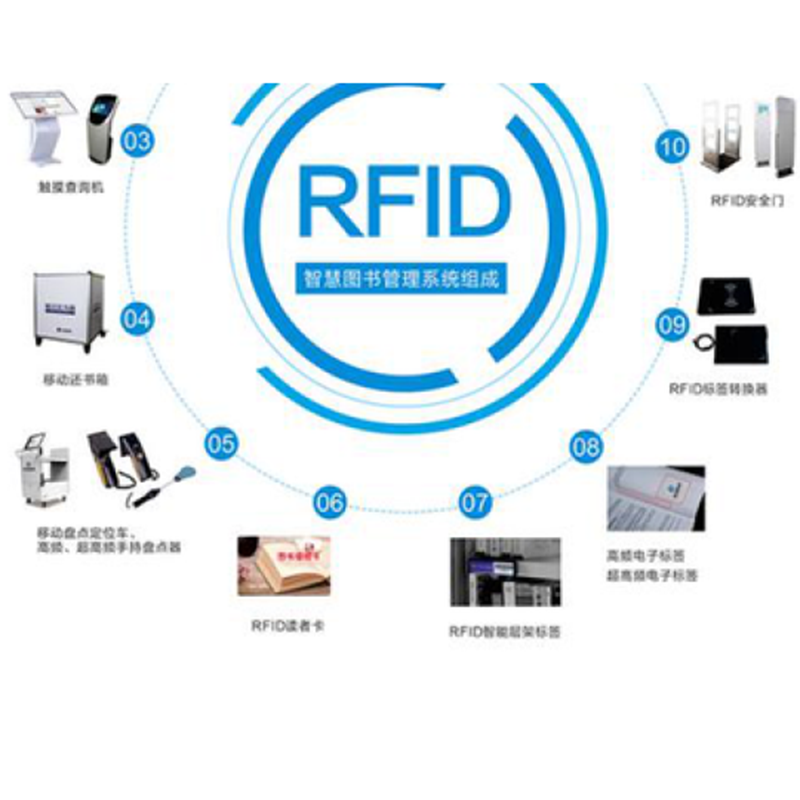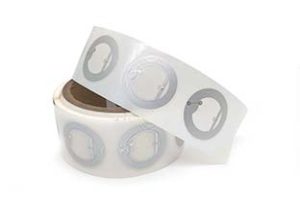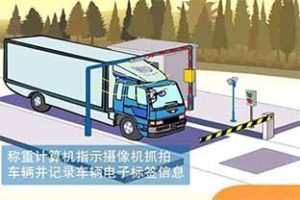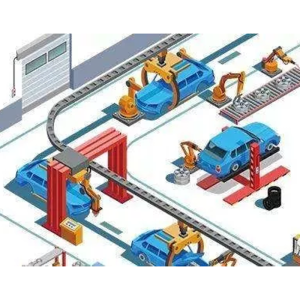RFID RFID tag technology related knowledge!
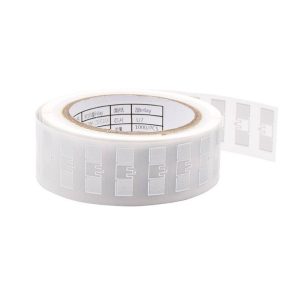
RFID tag is the popular name of RFID radio frequency tag identification (RFID). It is composed of tag, reader and data transmission and processing system. Volume label, also known as RFID label or smart volume label, is a chip with an antenna in the memory, which stores information that can identify the target RFID volume
It has the characteristics of persistence, strong penetration of information reception and transmission, large capacity of information storage, and many types. Some RFID volume labels support read and write functions, and the information of the target object can be updated at any time The interpreter is divided into two types: Handheld and fixed. It is composed of transmitter, receiver, control module and transceiver. The transceiver is connected with the control computer or programmable logic controller (PLC) to realize its communication function. The interpreter also has an antenna to receive and transmit information.
Data transmission and processing system: the reader receives the read data by receiving the radio waves sent by the tag. The most common is the passive RFID radio frequency tag system. When the reader meets the RFID tag, it sends out electromagnetic waves, forming electromagnetic fields around it. The tag obtains energy from the electromagnetic fields to start the microchip circuit in the label. The chip converts the electromagnetic waves, and then sends them to the reader, which converts them into relevant data. The control calculator can process these data for management control. In the active RFID RFID tag system, the battery installed in the label moves within the effective range.
RFID RFID tag technology related knowledge!
RFID label and barcode
What is the difference between RFID technology and barcode? Conceptually, the two are very similar, with the purpose of quickly and accurately confirming and tracking the target object. The main differences are as follows: whether it has the ability to write information or update memory. The memory of the barcode cannot be changed. Unlike bar codes, RFID RFID tags have unique identifiers that cannot be copied. The role of tags is not limited to the field of view, because information is transmitted by radio waves, and bar codes must be within the field of view. Due to the low cost of bar code, the perfect standard system and the global dissemination, it has been widely accepted. On the whole, RFID RFID technology is limited to a limited market share. At present, a variety of barcode control templates are already in use. In terms of access to information channels, RFID RF tags also have different standards.
RFID RFID tag technology related knowledge!
RFID RF tag card
RFID RFID tag technology and barcode are two different technologies, which have different application scopes and sometimes overlap. The biggest difference between the two is that the barcode is a visual technology scanner that works under the guidance of people and can only receive the barcode within its field of vision. In contrast, RFID does not require the target to be seen. RFID tags can be read as long as they are within the range of the receiver. The bar code itself has other disadvantages. If the label is scratched, contaminated or peeled off, the scanner cannot recognize the target. Bar codes can only identify producers and products, not specific goods. The bar codes pasted on all packages of the same product are the same, and it is impossible to identify which products have expired first.
At present, in terms of cost, due to different components, smart labels are much more expensive than bar codes. The cost of bar codes is the cost of paper and ink for bar codes. The price of active RFID RF labels with memory chips is more than $2, and the cost of passive RFID RF labels is also more than $1. However, the price of labels without built-in chips is only a few cents. It can be used in cases where data information requirements are not so high, but also has anti-counterfeiting functions that bar codes do not have.
RFID RF tag card
RFID RFID tag technology related knowledge!
RFID RFID tag volume label in RFID tag
RFID RFID tag is a volume label containing the code of the unique identification system of the item. This unique identification system includes the product electronic code EPC, universal identification number ucode, vehicle identification code VIN, international securities identification number isin, IPv6 and so on. Among them, the product electronic code (EPC) is a branch of the global product code, which can identify targets outside the field of vision. The electronic product code is not only a radio wave barcode, but also contains a series of data and information, such as origin, date code and other key supply information. These information is stored in a small silicon chip, and producers and retailers can know the accurate product and inventory information at any time by using labels, interpreters and computer networking.
RFID tags can store data ranging from 512 bytes to 4 megabytes depending on the type of business. The data stored in the volume label is determined by the application of the system and the corresponding standards. For example, the volume label can provide the production, transportation and storage of products, and can also identify the identity of machines, animals and individuals. These are similar to the information stored in bar codes. The volume label can also be connected to the database to store the information of product inventory number, current location, status, sales price and batch number. Accordingly, the RFID RFID label can directly determine the meaning of the code without referring to the database when reading data.
RFID RF tag card
RFID RFID tag technology related knowledge!
At present, the price of RFID RFID label varies from 30 cents to 50 dollars depending on the label type and application. In general, the smart label used in high-end products is more than 50 cents, and the active label is much more expensive, and the price with complex sensitive components is more than 100 dollars. The purpose of RFID tag is to use a unified standard of electronic product code, so that products can be identified in different fields.
RFID RF tag card in RFID tag
At present, many companies producing RFID products adopt their own standards, but there is no unified standard in the world. At present, several standards that can be used for RFID RF tag cards are iso10536, iso14443, iso15693 and iso18ooo. Iso14443 and
Iso15693, these two standards are composed of four parts: physical characteristics, RFID RF tag power and signal interface, initialization and anti-collision, and transmission protocol.
RF tag card
RFID RFID tag technology related knowledge!
In different ways, RFID RF tag cards are classified as follows:
1. It is divided into active card and passive card according to power supply mode.
Active means that there is a battery in the card to provide power, which has a long distance, but has limited life, large volume, high cost, and is not suitable for working in harsh environments;
There is no battery in the passive card. It uses the beam power supply technology to convert the received RFID RF tag energy into DC power supply to supply power for the circuit in the card. Compared with the active card, it has a shorter operating distance, but a longer service life and low requirements for the working environment
2. According to carrier frequency, it is divided into low-frequency RFID RF tag card, intermediate frequency RFID RF tag card and high-frequency RFID RF tag card. Low frequency RFID RF tag cards mainly include 125kHz and 134 kHz. There are two types of 2KHz, and the frequency of intermediate frequency RFID RF tag card is mainly 13. 56mhz, high-frequency RFID RF tag cards are mainly 433MHz, 915MHz, 2. 45ghz, 5. 8GHz
Low frequency systems are mainly used in short-distance and low-cost applications, such as most access control, campus cards, animal supervision, cargo tracking, etc. If system is used for access control and application systems that need to transmit a large amount of data; High frequency system applications require long read-write distances and high read-write speeds
The antenna beam direction is narrow and the price is high, which is applied in train monitoring, highway toll collection and other systems
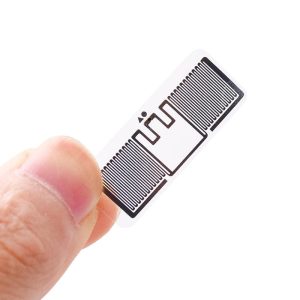
3. According to different modulation modes, it can be divided into active type and passive type. The active RFID tag card uses its own RFID tag energy to actively send data to the reader and writer; The passive RFID RF tag card uses the modulation scattering method to transmit data. It must use the carrier wave of the reader to modulate its own signal. This kind of technology is suitable for
It can be used in access control or traffic applications, because the reader and writer can ensure that only RFID RF tag cards within a certain range can be activated. In the case of obstacles, the energy of the reader/writer must come and go through the obstacles twice by using the modulation scattering method. The signal transmitted by the active RFID RFID tag card only passes through the obstacle
The RFID RFID tag card with active mode is mainly used in the application with obstacles, and the distance is longer (up to 30 meters).
4. According to the action distance, it can be divided into close coupling card (action distance is less than 1 cm), close coupling card (action distance is less than 15 cm), sparse coupling card (action distance is about 1 m) and long-distance card (action distance is from 1 m to 10 m, or even more).
RFID RFID tag technology related knowledge!
5. it is divided into read-only card, read-write card and CPU card by chip
RFID RFID tag reader in RFID tag in RFID system, signal receiving equipment is generally called reader (or card reader). The basic function of the reader is to provide an interface for data transmission with the volume label. RFID RFID tag antenna in RFID tag in RF device, when the working frequency increases to the microwave area, the matching problem between antenna and label chip becomes more serious. The goal of the antenna is to transmit the maximum energy into and out of the label chip. This requires careful design of the matching between the antenna and the free space and its connected label chip. The frequency bands considered in this paper are 435mhz, 2.45 GHz and 5.8 GHz, which are used in retail commodities. The antenna must be small enough to be attached to the required items; Having omnidirectional or hemispherical coverage directionality; Provide the most possible signal to the chip of volume label; The polarization of the antenna can match the interrogation signal of the card reader no matter what direction the object is in; Robust; Very cheap.
RFID RF tag
RFID RFID tag technology related knowledge!
The main considerations when selecting an antenna are:
Type of antenna;
Impedance of antenna:
Performance of RF applied to articles;
RF performance when there are other items surrounding the labeled items.
Possible options
There are two ways to use it: first, the tagged items are placed in the warehouse, and there is a portable device, which may be palm type, to ask all the items and need them to give information feedback; 2) Install a card reader at the door of the warehouse, ask and record the incoming and outgoing items. Another major choice is active or passive volume labels [1], [2].
RFID RFID tag technology related knowledge!
Optional antenna
At 435 MHz, 2.45 GHz and 5. The 8 GHz frequency is used in the RFID system. There are several types of antennas available, as shown in the table below. They focus on the size of the antenna. The gain of such a small antenna is limited and depends on the type of radiation mode. The omnidirectional antenna has a peak gain of 0 to 2dBI; The gain of directional antenna can reach 6dbi. The gain affects the operating range of the antenna. The first three types of antennas in the table below are linear polarization, but microstrip surface antenna can make circular polarization, while logarithmic spiral antenna is only circular polarization. Since the directionality of RFID tags is uncontrollable, the card reader must be circularly polarized. A circularly polarized label antenna can produce a 3dB strong signal.
RFID RFID tag technology related knowledge!
RFID RF tag
Impedance problem
For maximum power transmission, the input impedance of the chip behind the antenna must match the output impedance of the antenna. For decades, the antenna has been designed to match the impedance of 50 or 70 ohms, but it may be designed to have other characteristic impedance. For example, a slot antenna can be designed with an impedance of hundreds of ohms. The impedance of a folded dipole can be 20 times that of a standard half wave dipole. The lead out point of printed patch antenna can provide a wide range of impedance (usually 40 to 100 Ohm). It is crucial to select the type of antenna so that its impedance can match the input impedance of the label chip. Another problem is that other objects close to the antenna can reduce the return loss of the antenna. For omnidirectional antennas, such as double dipole antennas, this effect is significant. Some actual measurements were made by changing the distance between the double dipole antenna and a can of tomato sauce, showing some changes, as shown in Fig. 4 and Fig. 5. Other objects have similar effects. In addition, the dielectric constant of the object, not the metal, changes the resonant frequency. A plastic bottle of water reduces the minimum return loss frequency by 16%. When the distance between the object and the antenna is less than 62.5mm, the return loss will lead to an insertion loss of 3.0 dB, while the free space insertion loss of the antenna is only 0.2db. The antenna can be designed to match the situation of approaching objects, but the behavior of the antenna is different for different objects and different object distances. It is infeasible for omnidirectional antenna, so the design of antenna with strong directivity is not affected by this problem.
RFID RFID tag technology related knowledge!
Radiation mode
The mode of the antenna was tested in a non reflective environment, including all kinds of objects that need to be labeled. The performance of the omni-directional antenna was seriously degraded. The performance degradation caused by cylindrical metal hearing was the most serious. When it was 50mm away from the antenna, the return signal decreased by more than 20dB (see Figure 6). When the center distance between the antenna and the object is 100-150mm, the return signal decreases by about 10-12db. Several bottles of water (plastic and glass) were measured at a distance of 100mm from the antenna, as shown in Figure 7. The return signal decreased by more than 10dB. Similar results were obtained on the liquid in wax cartons and even on apples
RFID RF tag
RFID RFID tag technology related knowledge!
Influence of local structure
When using hand-held instruments, a large number of other nearby objects seriously distort the radiation mode of the card reader antenna and label antenna. This can be used for 2. The calculation of 45ghz operating frequency assumes a representative geometric shape, as shown in Figures 8, 9 and 10. Compared with the free space, the return signal is reduced by 10dB. When the dual antennas are used at the same time, it is much lower than the expected mode. Fig. 11 and FIG. 12 are the received signal contours of a cross-sectional plane in front of an antenna, showing serious distortion. In the use environment of the warehouse, there will be problems with a label on an item box, and several labels will be pasted on a box to ensure that a label can be seen at all times. The use of portable systems has several antenna problems. Two antennas in each box are enough for the access control device to detect, so the impact of local structure is no longer important, because the card reader antenna of the access control device is fixed in the entrance and exit of the warehouse, and directly points to the object with the label. The gain of the distance RFID antenna and the use of active label chip will affect the service distance of the system. For optimistic consideration, when the radiation intensity of electromagnetic field meets the relevant standards of UK, 2. Under the passive condition of 45ghz, full wave rectification, the driving voltage is less than 3V, the optimized RFID antenna impedance environment (impedance 200 or 300 Ohm), and the use distance is about 1m
[3]. If the WHO restriction [4] is used, it is more suitable for global use, but the operating distance is reduced by half. These limits the power of the electromagnetic field from the card reader to the tag. The operating distance decreases with the increase of frequency. If active chips are used, the operating distance can reach 5 to 10 meters.
RFID card
RFID RFID tag technology related knowledge!
Summary
Omnidirectional antenna should be avoided in label. However, directional antenna can be used, which has less interference of radiation mode and return loss. The selection of antenna type must match its impedance with free space and ASIC. It seems impossible to use antennas in a warehouse,
Unless an active tag is used, but in any case, the antenna radiation mode in the warehouse will be seriously distorted. The use of an access control system will be a good choice. Passive tags with short operating range can be used. Of course, the access control system is more expensive than the handheld instrument, but the handheld instrument staff
You need to use it to search for items in the warehouse, and the personnel cost is also expensive. In the access control system, each item box only needs two RFID tags instead of four or six.
RFID RFID tag technology related knowledge!
RFID RF tag frequency in RFID tag
The receiving range of RFID reader is affected by many factors, such as radio frequency, size and shape of label, energy of reader, interference of metal objects, and other RFID RFID tag devices. In general, the effective receiving distance of low-frequency passive tags is within one foot, that of high-frequency passive tags is about three feet, and that of ultra-high frequency tags is between ten and twenty feet. For semi-active and active tags using batteries, the reader can receive signals 300 feet or more away. For low-frequency and high-frequency RFID tags, if the size of the label and the reader antenna are the same, the receiving distance can be multiplied by 1 by the diameter of the antenna. 4. This rule is applicable when the diameter is within 30 cm. Like the radio we listen to, RFID tags and interpreters should also be modulated to the same frequency
Rate to work. LF, HF and UHF correspond to RFID RF tags with different frequencies LF stands for low-frequency RFID RF tag, which is about 125kHz; HF stands for high-frequency RFID RF tag, which is about 13.54mhz; UHF stands for UHF RFID RF tag, which is within the range of 850 to 910mhz. In operation, there are four kinds of frequency bands, low frequency (125kHz), high frequency (13.54mhz), ultra-high frequency (850-910mfz), microwave (2.45GHz). Each frequency has its own characteristics and is used in different fields, so it is necessary to select the appropriate frequency to use correctly
RFID electronic tag
RFID RFID tag technology related knowledge!
At present, different countries use the same frequency, but also different. At present, the UHF used in Europe is 868mhz, while that in the United States is 915MHz. At present, Japan does not allow UHF to be used in RFID technology. The government also limits its impact on other devices by adjusting the power supply of the interpreter. Some organizations, such as the Council for the promotion of global commerce, are encouraging the government to lift the restrictions. Label and reader manufacturers are also developing systems that can use different frequencies to avoid these problems.
Different frequencies have different characteristics, so their uses are various. For example, low-frequency labels are cheaper than ultra-high-frequency labels, which save energy and have strong force to penetrate waste metal objects. They are most suitable for objects with high moisture content, such as fruits. UHF has a wide range of functions and fast data transmission speed, but they consume energy and have weak penetration. There should be no too much interference in the operation area. It is suitable for monitoring items transported from the seaport to the warehouse. One of the problems encountered by RFID RFID technology is the reader conflict, that is, the information received by one reader conflicts with the information received by another reader, resulting in overlap. One way to solve this problem is to use TDMA technology. In short, the interpreter is commanded to receive signals at different times, rather than at the same time, so as to ensure that the reader will not interfere with each other. However, items in the same area will be read twice, so it is necessary to establish a corresponding system to avoid this situation.
RFID electronic tag
Donglai precision electronics, mainly engaged in RFID tag | RFID | RFID tag | RFID technology | RFID reader | RFID asset management system | RFID card | RFID equipment | electronic tag | RF tag | high frequency tag | library RFID tag | automatic identification technology solution
We will provide you with 1v1 technical consulting service free of charge! We have a 3000+square meter R&D center in Shenzhen Guangming pilot industrial base, and our R&D center has 12+laboratories. With strong R&D strength, we are a manufacturer you can trust. Welcome to call us for advice. Please contact us for free samples!
This article is included in Baidu Library


